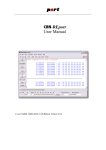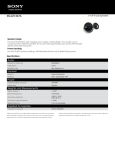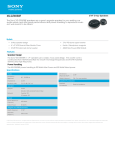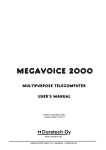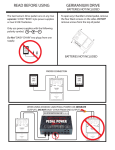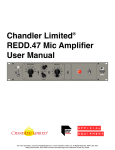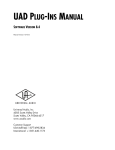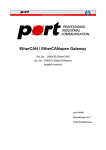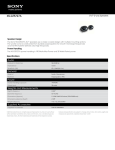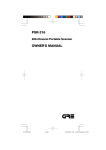Download Germanium Tone Control Manual
Transcript
GERMANIUM TONE CONTROL Thank you for purchasing the Chandler Limited Germanium Tone Control. This unit is proudly hand wired and assembled in the USA. It uses a 100% discrete transistor circuit and specially wound transformers. Included are item descriptions and hints to get you on your way. For peak performance, please allow the unit to warm up for at least 25 minutes before use. Please feel free to call our shop anytime for help or questions. Prior to sending in your gear for repair, please contact our shop at the number below. We will assist you in troubleshooting the problem and if needed, we will issue you an RMA# to send in the gear. Phone: 319-885-4200 Email: [email protected] Send repairs to: Chandler Limited, Inc. 222 S. Cherry Street Shell Rock, IA 50670 Connections - All connections on the Germanium are transformer balanced with pin 2 hot. Power supply - This is designed to be used with Chandler Limited PSU-1 MKII power supply. The power pin out is as follows: 1) chassis and audio ground 2) 48 volt 3) +28 volt 4) -28 volt Notes on Grounding - On the back of the power supply are two black banana connectors. These join the audio ground to earth ground with a solid wire between them. Depending on your studio you may want this connected or disconnected. Turn up your monitors or headphones a bit and experiment with which has a lower noise floor in your system. You may also need to join the audio banana plug to other sections of you studio to obtain lowest noise floor. The audio banana is located closest to the edge of the power supply case. Use something simple like a guitar cord and touch the tip to other portions of your studio to find best results. Controls and Features GAIN/GERMANIUM DRIVE - A gain switch in 3db steps, this is your standard input level type control. The actual amount of overall gain, however, is affected by feedback control. With gain at 0 and feedback at zero, overall gain is -30db. Moving the feedback to 10 overall gain becomes -8db with all the tonal changes described under the feedback control. Available gain of the unit is -30db with Gain and Feebdack at 0 to +25db with the Germanium Drive and Feedback at full. Using different combinations of feedback and input gain is essential if you want to take advantage of all the available tones from the Germanium pre amp. FEEDBACK - The Feedback control is essential to the sound and function of this EQ’s amplifier. . Audio amplifiers incorporate some amount of negative feedback which is where the output signal of the amplifier is fed back to its input. This affects the sound and function of the amplifier in many ways. THD, frequency response, gain and amplifier stabilization change considerably with varying feedback. Please refer to the section about unity gain for the tone variations available by using Gain and Feedback combinations. PASSIVE BYPASS ACTIVE BYPASS - You may bypass the passive Thick or low frequency section and the active Presence and Treble sections of the Tone Control separately for maximum flexibility. To bypass both at the same time, simply place the passive and active pushbuttons in the out position. Controls and Features continued INTERACTIVE INDEPENDENT INTERACTIVE/INDEPENDENT - As one of the important controls for flexibility, this switch affects how the Thick boost and cut interact to create variations of the EQ curves. In INTERACTIVE mode the boost and cut work in a similar manner to Pultec and Lang EQs whereby boosting and cutting at the same time makes the curves "interact" to create cool variations. For example, by boosting at 70hz and cutting at 240hz you get a drop near 350hz and a peak at 70hz. Boosting at 70hz and cutting at 320hz will give you a drop at 450hz and a peak at 70hz. Please note that different frequency choices will create different boost/cut curves. For example, when cutting at 320hz you will get a lower cut point by lowering the boost point. To illustrate the effect of INTERACTIVE further, if you were to do similar settings on a standard console EQ you would simply get the cut at 240hz or 320hz because the cut would take precedence over the boost. INTERACTIVE allows you to use both together to create normally unattainable equalizer responses. INDEPENDENT mode allows you to switch the low EQ to respond as a standard console EQ as mentioned above. In this instance you would normally use the low cut to shave off the very low muddy frequencies and possibly boost above it. Remember that in this mode the cut will take precedence! Uses for INDEPENDENT mode might be these: on a kick drum adding 50 or 70hz and cutting at 35 to remove the very low frequencies that could eat up your mix. Another would be using just the low cut to the same 35 or 50hz from a vocal or acoustic guitar track. The nice thing about INTERACTIVE/ INDEPENDENT is that you can accomplish similar results with different settings that create fun and useable variations in tone. See example settings. 60 40 150 200 4 240 320 30 6 7 2 8 1 20 OUT 5 3 9 0 10 CUT THICK CUT - The cut section has specific tunes sections for use in either INTERACTIVE or INDEPENDENT mode. The first four settings 20, 30, 40, and 60hz are tuned for use with the INDEPENDENT mode for removing very low frequncies problems. The curve is a very sharp 18db per octave and works well when boosting above the selected cut frequency, i.e., boost 35 or 50 and cut 20hz. As mentioned these are very effective at removing rumble from vocals and acoustic guitars because sharp slope does not dig into higher frequencies that would make the track thin. The second set of four points 150, 200, 240, 320 are tuned for use with the INTERACTIVE mode. The slope is a broad shelf type curve that helps make the beautiful interactions of boost and cut possible. It is also effective for creating thinning effects such as telephone sounds. Controls and Features continued 90 1 2 02 2 0 5 4 70 6 3 50 7 2 8 1 35 9 0 OUT 10 BOOST THICK BOOST - The THICK Boost is an all inductor passive circuit capable of the fat dense lows that inductor type EQs are known for. It is selectable between bell or shelf for flexibility and has 18db of boost so you can fatten up even the thinnest of instruments or tracks. I tend to like the 35, 50, and 70 bell for drums while the 90 and 120 shelf are very effective for big guitars and bass. See example settings. PRESENCE 3300 4100 1200 800 6200 0 2 2 4 4 6 8300 500 6 8 300 8 10 10 OUT PRESENCE - PRESENCE is an active section designed to sound like the many different British console EQs from years past. The twist to our PRESENCE control is that each frequency is tuned with a specific Q or width to make it most effective in areas where it will normally be used. 300, 500, and 800 have a sharper Q to make removing muddy mid range areas more effective. 1200 and 3300 have meduim Q while 4100, 6200, and 8300 are wide for smooth brightening of tracks. There is 15db of boost and cut available on the PRESENCE control and it is an all inductor based circuit for smooth pleasing tones. 8k2 6k8 10k TREBLE 12k 16k 2 0 2 4 4 2 0 k6 4k7 6 8 8 3k9 10 10 OUT TREBLE - TREBLE again is an active control designed in the British tradition. There is 18db of boost and cut available on eight frequncies (3k9, 4k7, 6k8, 8k2, 10k, 12k, 16k, 20k). It is also switchable between bell and shelf for flexibilty. The bell is purposely set at an even wider Q than PRESENCE section for smooth gentle highs. The TREBLE portion is an all inductor based circuit. Controls and Features continued WHERE IS UNITY ON THIS THING? - There are several ways to get unity gain from the Tone Control each with its own variations of frequency response, THD etc. Here are examples with basic descriptions of the tone of each. 1) Gain 2, Feedback 10 - Slight low end rise and gentle high end roll off. THD and noise are lowest of any unity gain setting. 2) Gain 5, Feedback 5 - Slight low rise with generally flat extended high end. THD is medium while noise is low but a few db higher than setting 1. This would generally be considered the "flattest" setting. 3) Gain 9, Feedback 2 - Flat low end with a gentle high end rise. THD is medium and noise is generally the same as setting 2. 4) Gain 10, Feedback 1.5 - Very slight low end roll off with a smooth high end rise. THD is highest of any unity gain setting and noise is roughly the same as 2 and 3. Other unity gain settings: Gain 3, Feedback 7 Gain 4, Feedback 6 Gain 6, Feedback 3.5 Gain 7, Feedback 3 Gain 8, Feedback 2.5 EXAMPLE settings- Gain and Feedback settings are omitted on these settings. Please refer to the section titled "where is unity gain on this thing" for more info. Tune these to taste and instrument. Interactive Kick 4 5 PASSIVE 6 3 7 2 1 4 9 0 10 5 6 3 8 2 4 5 6 7 2 8 1 4 9 0 10 5 60 8 2 50 2 8 1 9 0 OUT 8 9 0 90 10 4 5 7 8 2 9 1 0 OUT CUT 2 6200 0 2 4 4 8300 6 500 6 8 300 8 10 1200 6 3 50 PRESENCE 4100 8k2 10 3300 800 2 6200 0 2 4 6 8 300 8 10 4 6 8 8 3k9 10 8k2 10k 10 TREBLE 12k 6k8 0 2 16k 2 4 4 20k 6 4k7 6 8 3k9 10 8 10 10 OUT OUT BOOST 2 4 OUT 8300 6 500 0 2 16k 20k 6 10 4 TREBLE 12k 4k7 PRESENCE 4100 10k 6k8 OUT 120 220 35 10 7 3300 800 BOOST 70 7 1200 6 1 OUT 6 5 2 THICK 5 4 35 10 3 320 ACTIVE 10 9 4 240 20 INDEPENDENT 9 1 8 200 30 7 0 150 INTERACTIVE 120 220 3 CUT 40 3 2 90 70 7 0 OUT 6 6 1 PASSIVE BYPASS 5 3 320 ACTIVE Independent Kick 4 240 20 INDEPENDENT 9 10 THICK 200 30 7 0 150 INTERACTIVE 40 1 3 60 BYPASS 8 Acoutic Guitar- Martin HD28v with Neumann KM54 4 5 PASSIVE 6 3 7 2 1 4 9 0 10 60 BYPASS 8 5 6 3 8 1 320 6 2 8 9 0 90 120 220 4 70 7 1 OUT ACTIVE 5 3 20 INDEPENDENT 9 10 4 240 30 7 THICK 200 40 2 0 150 INTERACTIVE 50 1200 6 3 7 2 9 0 OUT CUT 8 1 35 10 5 10 3300 800 PRESENCE 4100 2 6200 0 2 4 4 8300 6 500 6 8 300 8 10 8k2 TREBLE 12k 0 2 16k 2 4 4 20k 6 4k7 10 6 8 3k9 8 10 10 OUT OUT BOOST 10k 6k8 Interactive Guitar- turning small guitar sound into a monster 4 5 PASSIVE 6 7 3 8 2 4 9 1 0 10 5 6 3 2 8 4 5 6 7 4 9 1 0 10 5 3 Interactive Bass 4 5 8 2 4 9 1 0 10 5 8 2 Independent Bass 4 5 6 3 7 1 9 0 10 4 5 60 8 0 2 9 150 4 240 320 5 2 8 1 9 0 OUT 4 5 7 8 9 1 0 6 8 10 3300 800 8k2 2 6200 0 500 4 6 8 300 8 10 10 3300 800 2 6200 0 2 4 6 8 300 8 10 4 5 1200 6 7 3 8 2 9 1 0 10 3300 800 6200 2 0 4 6 8 300 8 10 TREBLE 12k 0 2 16k 2 4 4 20k 6 6 8 8 10 8k2 10k 10 TREBLE 12k 6k8 2 16k 0 2 4 4 20k 6 4k7 6 8 3k9 8 10 8k2 10k 10 TREBLE 12k 6k8 16k 2 4 6 8 8 3k9 10 0 2 4 20k 6 4k7 10 10 OUT OUT BOOST 10 OUT 2 8300 6 500 10k 3k9 10 4 10 4k7 PRESENCE 4100 6 8 8 8k2 OUT 120 220 4 OUT 8300 6 500 2 20k 6 6k8 10 4 0 4 3k9 PRESENCE 4100 2 16k OUT 2 4 TREBLE 12k 4k7 PRESENCE 4100 10k 6k8 10 8300 6 BOOST OUT 4 8 300 1200 6 2 50 CUT 10 3 90 2 OUT 120 220 35 10 8 9 0 70 7 0 4 8300 6 500 BOOST OUT 6 3 7 1 50 2 6200 1200 6 2 90 THICK 200 5 3 35 10 10 PRESENCE 4100 OUT 4 70 8 9 120 220 50 CUT 20 INDEPENDENT ACTIVE 10 6 8 3300 800 BOOST OUT 7 0 30 9 1 5 3 7 0 35 10 1 40 7 2 320 INTERACTIVE 6 3 4 240 PASSIVE BYPASS 8 90 THICK 200 OUT ACTIVE 10 8 9 1200 6 1 70 7 2 20 INDEPENDENT 9 0 150 30 7 3 3 0 INTERACTIVE 6 6 5 2 OUT CUT 40 1 2 60 BYPASS 5 4 3 35 10 1 PASSIVE 6 7 320 OUT ACTIVE 10 9 4 240 120 220 50 THICK 200 20 INDEPENDENT 9 0 150 30 8 1 3 60 7 8 CUT 40 2 2 90 70 7 0 INTERACTIVE 6 6 1 PASSIVE BYPASS 8 2 5 3 320 OUT ACTIVE Interactive Snare 4 240 20 INDEPENDENT 9 10 THICK 200 30 7 0 150 INTERACTIVE 40 1 3 60 BYPASS Vocal- U67 or Horch RM2j 4 5 PASSIVE 6 3 7 2 8 1 9 0 10 60 BYPASS 4 5 2 8 1 6 2 8 9 0 90 120 220 4 70 7 1 OUT ACTIVE 10 320 5 3 20 INDEPENDENT 9 0 4 240 30 7 THICK 200 40 6 3 150 INTERACTIVE 10 7 2 8 1 35 9 0 OUT 1200 6 3 50 CUT 5 10 3300 800 PRESENCE 4100 6200 2 0 2 4 4 8300 6 500 6 8 300 8 10 8k2 TREBLE 12k 16k 2 4 6 8 3k9 10 0 2 4 20k 6 4k7 8 10 10 OUT OUT BOOST 10k 6k8 Vocal- Manley Reference or C12 type 4 5 PASSIVE 6 3 7 2 8 1 9 0 10 60 BYPASS 4 5 INTERACTIVE 40 6 8 2 0 10 4 320 ACTIVE 5 6 3 7 2 8 1 20 INDEPENDENT 9 1 THICK 200 240 30 7 3 150 OUT 9 0 CUT 10 90 70 120 220 4 5 50 7 2 8 1 35 OUT 1200 6 3 9 0 BOOST 10 800 3300 PRESENCE 4100 6200 2 0 2 4 4 8300 6 500 6 8 300 8 10 OUT 10 8k2 6k8 10k TREBLE 12k 16k 2 0 2 4 4 20k 6 4k7 6 8 3k9 8 10 OUT 10 CE Certification Chandler Limited declares under its sole responsibility that all products manufactured by them are in compliance with EC directives 2004/108/EC Electromagnetic Compatibility; 2004/108/EG Electromagnetic Compatibility; 2006/95/EC Low Voltage Equipment Safety.








